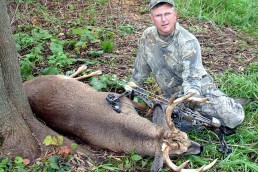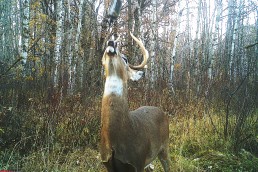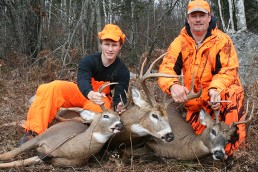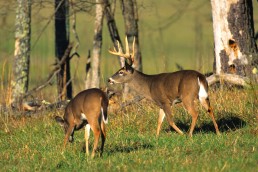It’s All About the Bucks: The Scoop on Scrapes
SHARE THIS POST
Freshly pawed-up black earth along with the scent of deer urine and a mangled branch above all mean one thing to a bowhunter: a whitetail buck has been by this exact spot recently. Why whitetail deer make scrapes and how they can affect your hunting strategy is what this article is all about.
Arguably, much misinformation has been passed along by various sources on what scrapes are, what sex of deer make them, and the role scrapes actually play in the fall mating ritual.
Here’s a sampling of three common misnomers about scrapes:
1) scrapes are made by a specific buck to attract a doe
2) does seek out scrapes to find bucks and breed
3) large scrapes are made by big bucks, and small scrapes are made by smaller bucks
None of these claims are actually true. No matter what you might have heard or read about scrapes, here’s what my observations tell me is the real scoop on scrapes.
In general, scrapes are made by bucks, both young and old, to communicate with other bucks. In other words, scrapes have very little to do with does. Scrapes are created by various resident bucks in order to advertise their own dominance and presence in a given area. I believe bucks also make scrapes to keep tabs on all the other bucks in the area. In fact, once a scrape is made by any buck in the herd, no matter what his hierarchy rank, it is likely to be visited and reworked by another buck without hesitation.
On many occasions, I have watched both the smallest yearling spike buck as well as the largest-racked “Booner” work over the same scrape at various times on the same day. However, I’ve seen far more young and middle-aged bucks spending time at hot scrapes than monster-racked brutes. In fact, quite often I’ve witnessed the biggest bucks ignore scrapes entirely. Just this past fall, I watched a bachelor group of six bucks gather near a small water hole that had several scrapes clustered around the pond perimeter. This bachelor group contained three yearlings sporting their first racks, two 2 1/2-year-old 8-pointers, and one dandy 3 1/2-year-old 10-pointer. Ironically, the three yearlings spent more time at the scrapes than did the older bucks. The biggest buck in the group, the 10-pointer, only worked one scrape briefly. Actually it spent most of its time working the “licking branch” over that specific scrape. It never did actually paw the ground, nor urinate in it. Neither 8-pointer made any attempt to work one of the nearby scrapes. Instead, they drank from the water hole, and briefly rubbed on a nearby large tree.
Are you enjoying this post?
You can be among the first to get the latest info on where to go, what to use and how to use it!
Yet, the very next morning, sitting in the same stand, I observed a lone 3 1/2-year-old 10-pointer with a thick rack and immense body make a beeline for one of the same scrapes the yearlings were working the night before. Once he arrived at the scrape cluster, he took his time working every single scrape––four to be exact. He thoroughly worked over every licking branch above the scrapes, pushing his face into the branches in an effort to deposit scent from his forehead and preorbital glands. After the licking branch ritual, he’d paw out some dirt at each site and urinate in it. What a sight! Admittedly, this was too much to resist. I eventually drew my bow back as he stood in the fourth scrape and drilled him at 28 yards.
What do these observations prove? To me, it’s obvious. It was all about buck communication. While I saw several does near this water hole on these two consecutive hunts, none of the does showed even the slightest interest in these scrapes. They drank, browsed, and left. The only deer interested in the scrapes were males (bucks). Some bucks were more obsessed with scraping than others. Perhaps this is due to an increased level of the male hormone testosterone in certain animals. It might also be a specific behavioral trait of certain bucks simply being more aggressive than others. Collectively, I have learned from this observation as well as others that the best scrapes are located in clusters near high deer traffic areas. If you sit over spots containing “scrape clusters,” you are probably going to see some action.
It is important to note that every good ground scrape usually contains a “licking branch” above it. My observations suggest the licking branch above a scrape is critical. In fact, I wouldn’t hesitate to say that the licking branch is even more important than the scrape itself. It’s a good bet there are target licking branches throughout any good deer hunting property that don’t even have a scrape below them.
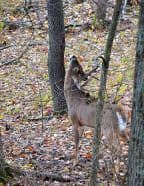
Many deer biologists suggest the licking branch is actually the more critical element than the pawed-out earth below it. Licking branches are likely specific deer communication centers. As a buck works a licking branch, he is trying to deposit his own signature scent from his face and forehead area, and announce that he has traveled by this spot. At the same time, he is probably scent checking the licking branch in order to determine if any other bucks have visited recently. Some of the best licking branches are visited by bucks year round.
Scrape size is yet another subject worth noting. Some scrapes are much bigger than others, simply because they are visited more often, and are hit by a number of bucks. Biologists often referred to these as “community scrapes.” Community scrapes continue to get bigger and bigger throughout the fall season, because they keep getting hit again and again. They are positioned in spots that see constant deer travel. As you can well imagine, these are the best of all scrapes to hunt.
In a nutshell, the key to hunting any hot-looking scrape area is to pick a vantage point that is downwind from the scrape. Bucks are nearly always on high olfactory alert when approaching a scrape, because they are scenting the area for the location of the scrape and the presence of other bucks. Pick a tree that allows you to see the buck approaching the scrape area from a fair distance. This allows you to ready yourself for a bow shot.
Finally, time your draw (of the bow) so it occurs when the buck is busy working the licking branch or pawing the ground. With any luck, a dandy buck will be standing broadside with its face buried in the branches when you release your arrow.
After that, it’s time for pictures, and fresh venison.
MWO
SHARE THIS POST
Did you enjoy this post?
You can be among the first to get the latest info on where to go, what to use and how to use it!
Joe Bucher
Joe Bucher is a Freshwater Fishing Hall of Fame Legendary Angler, book author, lure designer and host of Fishing with Joe Bucher TV series.
